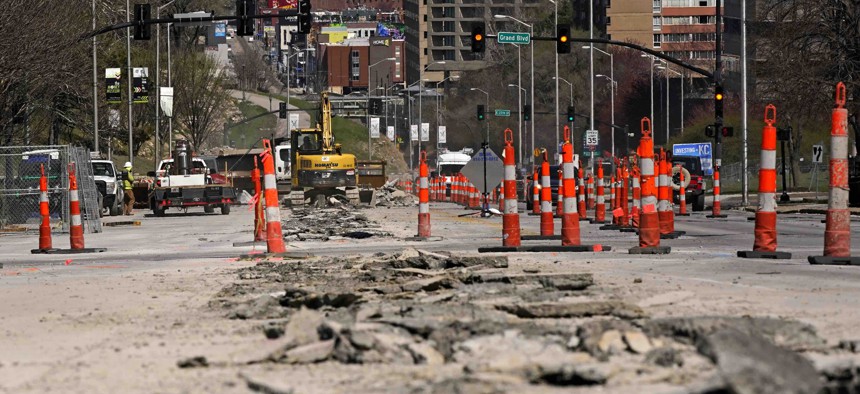The Many Flavors of 'Transformative' State and Local ARPA Spending

In this March 30, 2021 file photo, workers replace old water lines under Main Street as part of work to update water and sewer systems as well as prepare the road for the expansion of a street car line in Kansas City, Mo. Water infrastructure is one way communities can spend American Rescue Plan Act aid. AP Photo/Charlie Riedel
Transformative government projects using American Rescue Plan Act funds can run the gamut from improving a local park, to spending tens of millions to alleviate homelessness.
When it comes to how state and local governments are planning to use federal aid flowing under the American Rescue Plan Act, "transformative" is a common way that public officials and others are describing the types of investments the funding will allow for.
Emily Brock, who directs the Government Finance Officers Association's Federal Liaison Center, highlighted during the group's conference last week the frequency with which the term was coming up. "A lot of GFOA communities are thinking about transformational projects," she said. But she also noted that how these projects look can vary widely from place to place. "Transformative projects are sometimes in the eye of the beholder," she said.
Generally speaking though, she explained that GFOA members seem to be defining these projects as those where spending now will have a lasting affect on their communities.
Asked about what transformational ways their jurisdictions are planning to use ARPA funds, areas GFOA members identified included: waterworks upgrades, particularly those that help address the effects of climate change; broadband accessibility; Enterprise Resource Planning, or ERP, accounting systems; housing and homeless shelters; school facilities; expanding online services; and reducing "blight"—usually a reference to abandon or rundown buildings.
One example of this type of spending is in Austin, Texas, where the City Council in June opted to dedicate nearly $100 million of its $188 million ARPA recovery funding allotment to homelessness programs.
"The highest priority for the city and the council is and has been homelessness. We don't want people living in tents anywhere in our city. We really want to get people in homes, places where they can get services and improve their lives," Mayor Steve Adler said in a statement at the time.
"This is a once-in-a-lifetime opportunity for Austin," he added.
During GFOA's panel, Rafiu Ighile, finance director for Howard County, Maryland, flagged technology related to telework, digital services and cybersecurity as potential areas where the county was looking at transformational spending.
Laura Allen, town manager of Berwyn Heights, Maryland, said a transformative investment her community is considering has to do with making improvements to a small park to better handle rainfall. "This is a location that's been identified by the county as having regional, as well as local, drainage capacity impacts," she said.
Brock pointed out that under the rules for ARPA, spending on water, sewer and stormwater infrastructure doesn't need to be tied to a community's Covid-19 response to be an eligible use. She also noted how GFOA's survey of members indicates that when it comes to the various transformational investments communities are planning, physical and technological infrastructure are areas where there's concentrated interest.
But investments that might be characterized as transformative don't end there and the range they run speaks to some extent to the flexibility states and localities have in how they use their ARPA funding. "To provide food security to a single person in your community may be transformative," Brock said.
Bill Lucia is a senior editor at Route Fifty and is based in Olympia, Washington.
NEXT STORY: Why There’s Rising Interest in Giving More Updates to Bondholders






